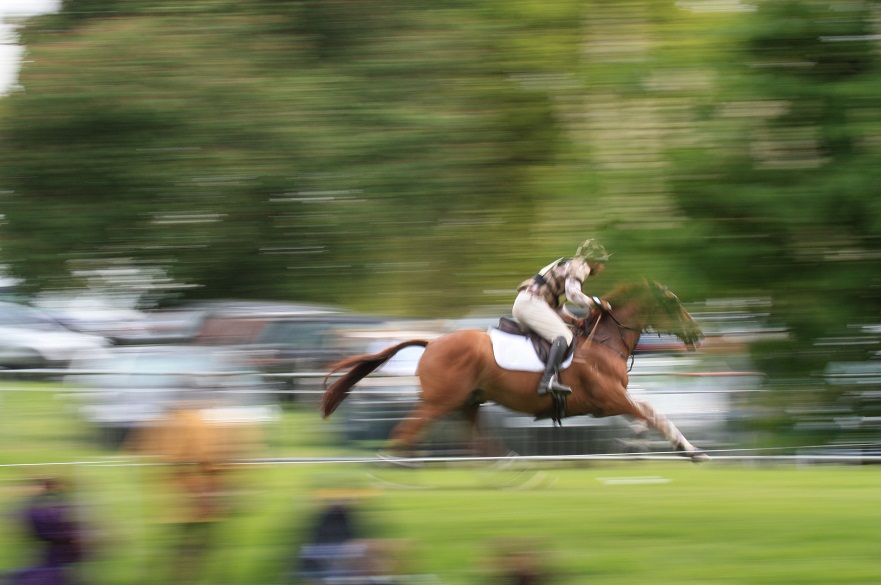Ten fence types at increased odds of a fall for horse and rider
New research into equestrian eventing safety has assessed different types of fence and course design, and quantified their associated risk of falling for either rider or horse.
By Dave Rogers | Published on 1 August 2022
Categories: Press office; Research; School of Animal, Rural and Environmental Sciences;

The study is published in the Equine Veterinary Journal, and has highlighted ten fence types which are at increased odds of a fall occurring when compared with square spread fences. Seven types of fence were found to be at reduced odds of a fall. Twelve other factors related to fence and course design were also identified as affecting the risk of falls occurring.
Eventing is a challenging equestrian sport including three phases: dressage, show jumping, and cross-country. Cross-country involves riding at speed over a course of fences and is the most dangerous phase because falls can happen at fences. Around 6% of starts result in a fall – with either the rider falling off the horse, or the horse itself falling. Falls can have very serious consequences, up to and including death for both the horse and rider. Since 2016 there have been at least 41 horse fatalities and at least 18 rider fatalities.
The study assessed fence eventing risk factors, covering aspects of fence design and course design. Researchers found that fence types were at increased odds of a fall occurring compared to square spread fences, and seven types were at reduced odds. Fences positioned with approach and/or landing downhill were more likely to have falls occur than fences on flat ground, and fences which were a jump into water were risker than jumps onto solid ground.
The study team, at the Universities of Glasgow, Bristol, and Nottingham Trent, analysed data from over 200,000 fences in about 6,500 competitions over an 11-year period, and, overall, found thirteen factors related to competition, fence, and course design that meant falls were more likely to occur.
Researchers believe that this study offers a starting point for establishing a scientific ‘risk profile’ of cross-country courses which can help athletes and trainers plan for future success, and safeguard safety and welfare.
Lead author Dr Euan Bennet from the University of Glasgow, who started the work at the University of Bristol, said: “More than two decades after the International Eventing Safety Committee urged that ‘everything should be done to prevent horses from falling’, an improved understanding of the true level of risk posed by a particular series of fences on a specific course is an essential focus of further risk reviews.
“However, it would not be desirable to look at our results and say, for example, that challenging jumps should no longer be used. Rather, it should be recognised that course design can prioritise safety without reducing challenge or competitiveness in the sport. ‘Risk grading’ of courses would be an important way of informing athletes about the level of risk to which they would be exposing themselves and their horse and would reduce the risk of serious and fatal injury to both horses and riders.”
Dr Heather Cameron-Whytock, a researcher in Nottingham Trent University's School of Animal, Rural and Environmental Sciences, said: “This study is the critical next step in the eventing safety research from our team. We are continuing to work towards a marginal gains approach to risk management, where many small adjustments are made to reduce the risk of injury and fatality to horses and riders.”
The study, ‘Fédération Equestre Internationale (FEI) eventing: Fence-level risk factors for falls during the cross-country phase (2008-2018)’ is published in Equine Veterinary Journal. The work was funded by the Fédération Equestre Internationale.
Notes for Editors
Press enquiries please contact Dave Rogers, Public Relations Manager, on telephone +44 (0)115 848 8782, or via email.
Nottingham Trent University (NTU) received the Queens Anniversary Prize for Higher and Further Education in 2021 for cultural heritage science research. It is the second time that NTU has been bestowed the honour of receiving a Queen’s Anniversary Prize for its research, the first being in 2015 for leading-edge research on the safety and security of global citizens.
The Research Excellence Framework (2021) classed 83% of NTU’s research activity as either world-leading or internationally excellent. 86% of NTU’s research impact was assessed to be either world-leading or internationally excellent.
NTU was awarded Outstanding Support for Students 2020 (Times Higher Education Awards). It was the University of the Year 2019 (Guardian University Awards, UK Social Mobility Awards), Modern University of the Year 2018 (Times and Sunday Times Good University Guide) and University of the Year 2017 (Times Higher Education Awards).
NTU is the 5th largest UK institution by student numbers, with over 33,000 students and more than 4,000 staff located across five campuses. It has an international student population of 4,000 and an NTU community representing around 160 countries.
In the past 15 years, NTU has invested £450 million in tools, technology and facilities.
NTU is in the UK’s top 10 for number of applications and ranked first for accepted offers (2019 UCAS UG acceptance data) It is also among the UK’s top five recruiters of students from disadvantaged backgrounds.
75% of NTU students go on to graduate-level employment or graduate-entry education / training within fifteen months of graduating (Guardian University Guide 2021).
NTU is 4th globally (and 3rd in the UK) for sustainability in the 2021 UI Green Metric University World Rankings (out of more than 900 participating universities).